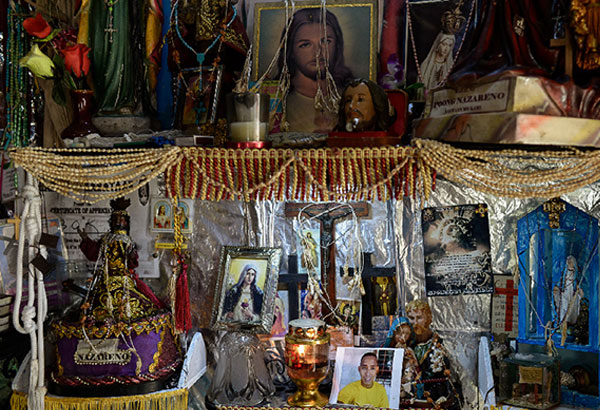The Night Weeps

A photo of Alvin Jhon Mendoza is placed on the altar of his family’s small home in Manila. Mendoza, 23, was killed on Oct. 12, 2016 by unidentified riding-in-tandem gunmen while he was eating in a canteen near his home. The victim was not in the village drug watchlist. Photos by Eloisa Lopez
MANILA, Philippines — There is an image of a man, seated on a monobloc chair, his body slumped on the table of a funeral parlor. In the picture, the man identifies and confirms the identity of the deceased body of his son. Another image shows a woman holding a candle, her eyes tightly shut, and in her face, she is pleading for justice. There are pictures of families grieving the loss of their loved ones; a body is sprawled on the street drenched in blood; protesters flash their placards to raise their indignation.
These are the grim realities that photographer Eloisa Lopez has captured in her coverage for online media outlet Rappler. She documents the havoc wreaked by the war on drugs, and follows the victims of extrajudicial killings day by day. As a young photographer, these scenes are sometimes captured in her Instagram — a social media platform that other young women use to broadcast more cheerful content. Her photographs are raw and emotional, seeking immediate empathy from viewers. Eloisa talks to Supreme about her work, and how as a young photojournalist, she copes with the demands of her job.
SUPREME: When did you start taking photos and what sparked your interest in photography?
ELOISA LOPEZ: I started taking photos for fun when I was in high school using my uncle’s camera that he would lend me sometimes. I took photos of almost anything I found interesting around our house — the plants, little figurines, and the sunset from our rooftop. It was mostly the seemingly magical ability of the camera to take something straight from my vision into a screen that got me hooked. I was just really fascinated with cameras.
Why did you decide to cover President Duterte’s anti-drug war and the issue of extrajudicial killings? What is it like covering this controversial subject?
When President Duterte promised to wage war against drugs just after winning the elections, it was not long before bodies started showing up dead on the streets of Manila. Many of my colleagues had begun covering it, knowing that the President was serious about his war. At the time, I was regularly assigned to lifestyle stories, and had little experience covering hard news. I figured the night beat would test my mettle as a journalist. And surely it did, but it also opened me to realities I was not aware of before. It made me a better journalist, but it also made me a bit cynical.
Covering the drug war is like dealing with heartbreak. You deal with the same issues over and over again, hoping to get good news the next day, only to find yourself pouncing on a much more heartbreaking story the next minute. It’s like a wound that keeps on bleeding, no matter how hard you treat it.
How do you take photos of EJK victims? Do you have a certain style that you apply?
Personally, I try not to make my photos too visual — not too gory, not too bloody — not only for the viewer’s sake but for mine as well. Editing photos of dead bodies after taking them, with barely any sleep, is not an easy task. And I wouldn’t want the viewer to look away from the photo just because there’s too much blood. That’s just defeating the purpose of taking the photo. I want the viewer to see what I saw, and feel something for it.
Since EJK centers on violence, how do you prepare yourself?
I don’t think there’s any way I could have prepared for what I’ve experienced covering the drug war. You cannot really prepare for reality when it just happens before your eyes. You just learn to deal with it better, report it better every day. My first night covering the drug war left me sleepless for weeks. But I knew that the only way to recover from the trauma was to get back into the night shift. I wouldn’t say I’m immune to the sight of dead bodies and the wailing of widows and mothers, but I am definitely much better in dealing with it. A colleague advised me that the best way to cover stories like this — stories with relentless suffering and pain and violence — is to learn how to compartmentalize. Put your feelings into little drawers in your head and keep them there while you do your work unbothered. Open them up when you need to, but don’t let them spill on the field.
What are the challenges you face every day during your coverage?
The biggest challenge is being a journalist and human first. When bereaved mothers, widows, and orphaned children pour out their stories to you, humanizing their loved ones, you cannot help but feel for them. Strictly speaking, this is beyond the work of journalists. Journalists are expected to keep calm in the face of suffering, to keep your opinions out of the story. But how do you do that when thousands of lives are under your watch? I’d rather be biased to the truth.
What have you learned so far?
Sometimes, evil wins.















